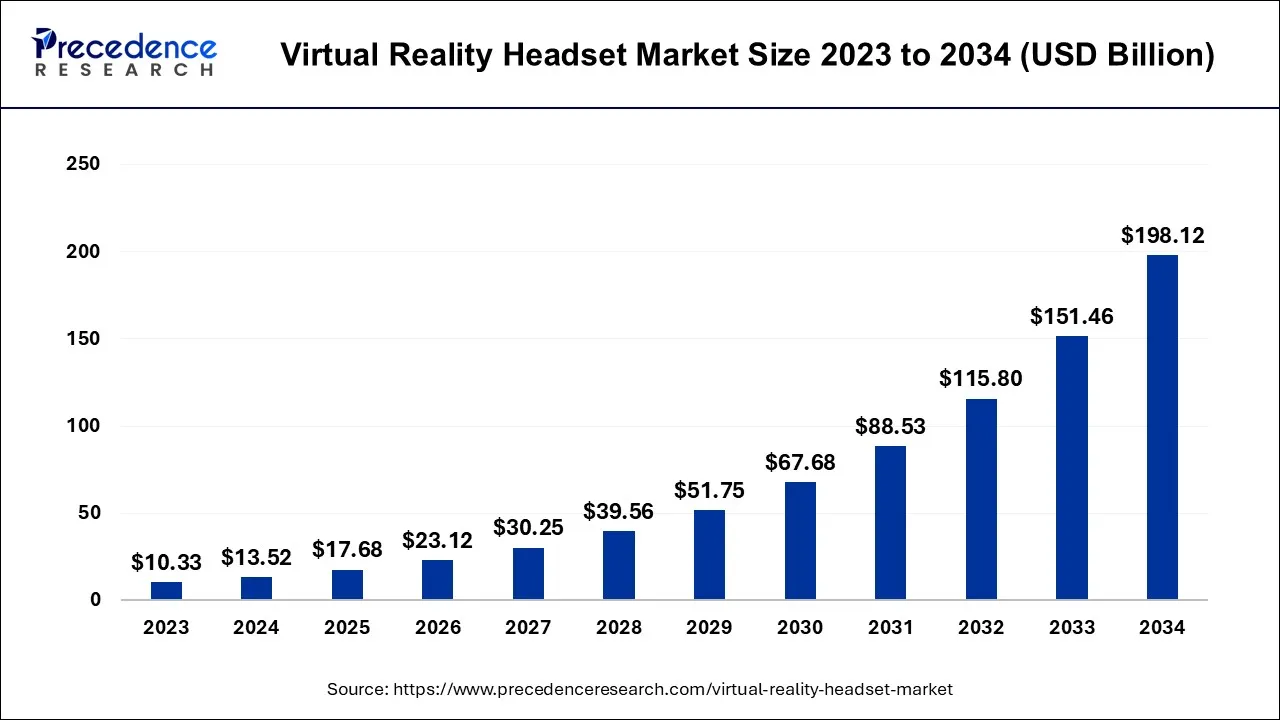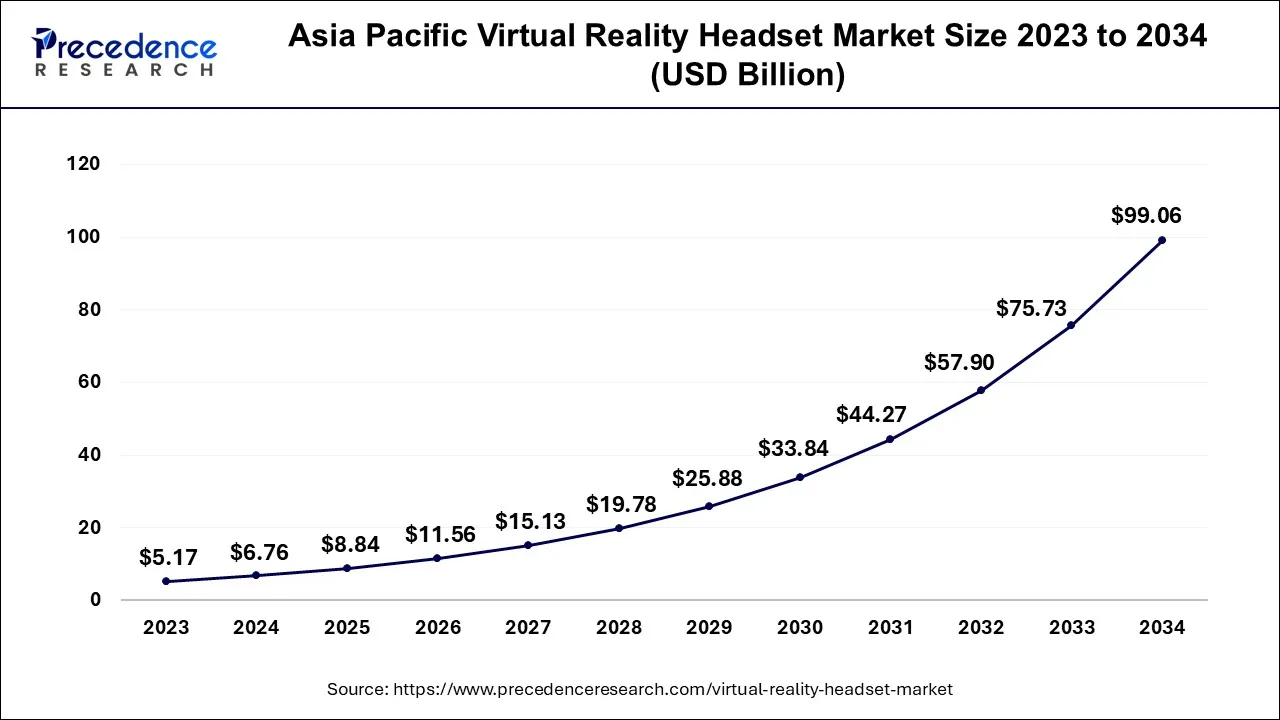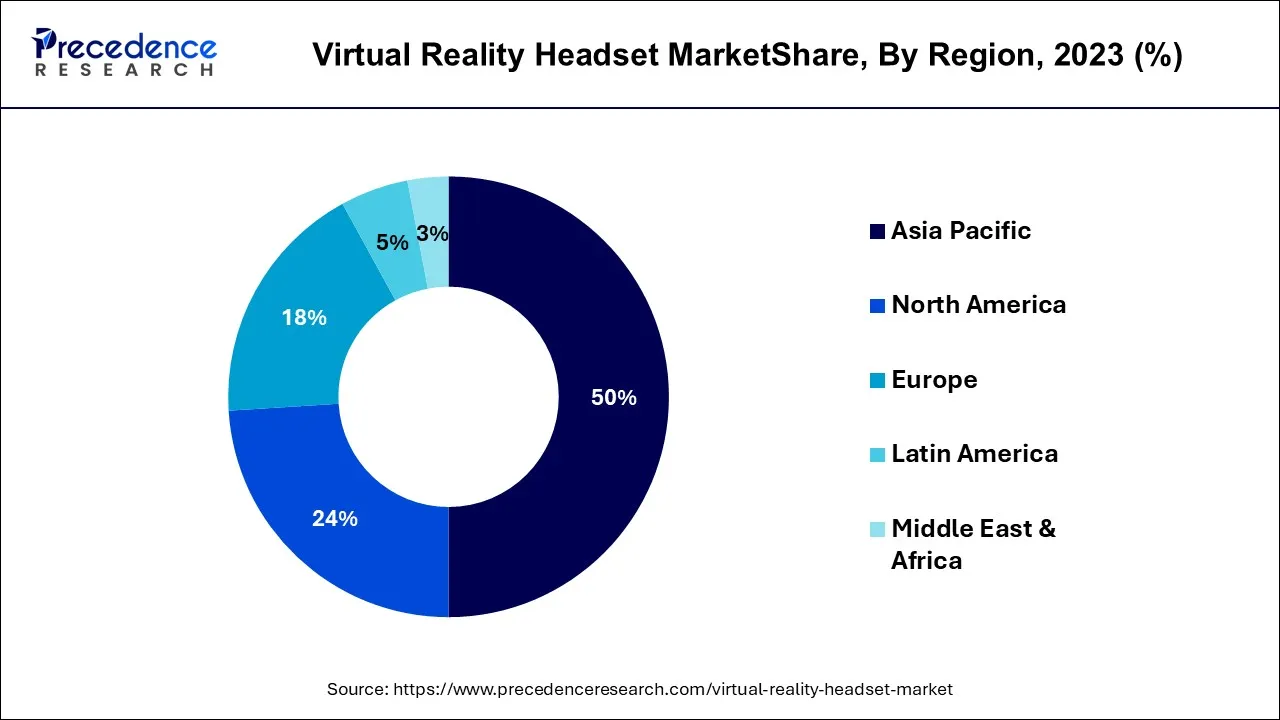What is the Virtual Reality Headset Market Size?
The global virtual reality headset market size was valued at USD 17.68 billion in 2025 and is anticipated to reach around USD 198.12 billion by 2034, expanding at a CAGR of 30.8% over the forecast period 2025 to 2034.

Market Highlights
- Asia Pacific contributed more than 50% of revenue share in 2024.
- By End-device, the high-end device segment has held the largest market share of 57% in 2024.
- By End-device, the low-end device segment is anticipated to grow at a remarkable CAGR of 35.3% between 2025 and 2034.
- By Product Type, the standalone product type segment generated over 44% of revenue share in 2024.
- ByProduct Type, the smartphone-enabled product type segment is expected to expand at the fastest CAGR over the projected period.
- By Application, the gaming segment had the largest market share of 30% in 2024.
- By Application, the education segment is expected to expand at the fastest CAGR over the projected period.
Market Size and Forecast
- Market Size in 2025: USD 17.68 Billion
- Market Size in 2026: USD 23.12 Billion
- Forecasted Market Size by 2034: USD 198.12 Billion
- CAGR (2025-2034): 30.8%
- Largest Market in 2024: Asia Pacific
Market Overview
The virtual reality headset industry has witnessed substantial expansion in recent times. These gadgets, represented by notable examples like Oculus Rift, HTC Vive, and PlayStation VR, transport users into immersive digital domains, serving various purposes from gaming to educational applications. The surge in popularity is a consequence of technological advancements, enriched content creation, and increased affordability.
Market leaders like Oculus (a division of Facebook), Sony, and HTC have asserted their dominance, although the sector remains competitive with the emergence of fresh contenders and a profusion of applications, spanning from gaming to medical simulations. The global VR headset market is poised for continued advancement, as ongoing innovations in both hardware and software augment accessibility and user engagement.
Virtual Reality Headset Market Growth Factors
Technological progress is a paramount driver of VR headset market growth. Ongoing innovations in display technology, graphics rendering, and tracking systems have led to improved resolution, reduced latency, and enhanced realism. These advancements create more immersive experiences, attracting consumers and businesses alike. Cutting-edge hardware and software developments also facilitate a wider range of applications, from gaming and education to healthcare and professional training.
Rich and diverse content is a critical factor propelling the VR headset market. As developers create an increasing variety of engaging VR experiences, the appeal of these devices grows. High-quality VR games, interactive simulations, and educational content make the technology more attractive and versatile. The availability of compelling content is a significant incentive for potential buyers, driving hardware sales and ecosystem growth.
Collaborations between VR headset manufacturers and other industries have played a crucial role in market growth. Partnerships with game developers, film studios, and educational institutions have led to exclusive content and promotional tie-ins. additionally, alliances with healthcare providers and enterprises have fueled the adoption of VR for training, therapy, and simulations. These partnerships leverage the strengths of VR technology across different sectors, resulting in increased adoption and integration.
Awareness and education efforts have helped demystify VR technology, reducing consumer hesitation. Marketing campaigns, in-store demos, and educational initiatives have clarified the benefits and potential uses of VR headsets. As consumers become more informed about the capabilities of VR, they are more likely to consider these devices for both entertainment and practical applications.
Market Scope
| Report Coverage | Details |
| Market Size in 2025 | USD 17.68 Billion |
| Market Size in 2026 | USD 23.12 Billion |
| Market Size by 2034 | USD 198.12 Billion |
| Growth Rate from 2025 to 2034 | CAGR of 30.8% |
| Largest Market | North America |
| Base Year | 2025 |
| Forecast Period | 2025 to 2034 |
| Segments Covered | End-device, Product Type, Application, and Region |
| Regions Covered | North America, Europe, Asia-Pacific, Latin America, and Middle East & Africa |
Market Dynamics
Drivers
Gaming and entertainment
The virtual reality (VR) headset market is experiencing substantial growth, primarily fueled by the influential contributions of the gaming and entertainment sectors. These domains, distinguished by their immersive and interactive qualities, have significantly captured the interest of consumers, thus sparking a notable uptick in VR headset adoption. Notably, the gaming industry has played a pivotal role in propelling the sales of VR headsets.
The exceptional caliber of VR games provides users with unparalleled experiences, enabling them to seamlessly step into virtual worlds, resulting in heightened engagement and an altogether elevated gaming experience. With ongoing investments from game developers in VR titles, exclusive content, and cross-platform compatibility, this foster sustained consumer interest and drives the adoption of VR hardware.
Concurrently, the entertainment sector, encompassing facets such as 360-degree videos, virtual concerts, and cinematic experiences, has harnessed the intrinsic potential of VR to deliver one-of-a-kind and immersive content. This has not only piqued the curiosity of technology enthusiasts but also broadened the appeal to a wider audience, rendering VR as an enticing platform for content consumption.
The harmonious interplay between gaming and entertainment has established VR headsets as versatile platforms for leisure, escapism, and social engagement, subsequently fueling market growth. As the quality of VR content continues to evolve, it is highly probable that gaming and entertainment will remain instrumental in driving the VR headset market, appealing to both novices and established users alike.
Restraint
Complex setup and requirements
The complexity of setup and hardware requirements is a significant restraint on the growth of the virtual reality (VR) headset market. While VR offers immersive experiences, the technical demands to use it can be daunting for many potential consumers. High-quality VR experiences typically necessitate powerful computers or gaming consoles, which can be expensive. Setting up these systems involves not only the headset but also tracking sensors, controllers, and sometimes external cameras.
The calibration and configuration process can be time-consuming and technically challenging for those not familiar with these technologies. Moreover, the need for a dedicated physical space to use VR effectively can be a limiting factor for people with limited room or those in shared living spaces. These complexities and hardware requirements deter users seeking a hassle-free experience, hindering the broader adoption of VR. Simplifying the setup process, reducing hardware demands, and enhancing user-friendliness are crucial steps to mitigate this restraint and broaden the VR market's appeal.
Opportunity
Content creation and development
Content creation and development are instrumental in forging substantial opportunities within the virtual reality (VR) headset market. The quality, diversity, and ingenuity of VR content serve as prime catalysts for engaging users and, consequently, stimulating market growth. Foremost, there is an escalating demand for top-tier VR content, spanning from immersive gaming adventures to educational simulations and virtual exploration. This burgeoning demand provides a vast canvas for content creators to explore, fostering the production of distinctive and enthralling experiences.
Furthermore, as VR technology evolves, developers are granted opportunities to push the envelope of what is achievable within the VR realm. This includes delving into interactive storytelling, enhancing visual fidelity, and experimenting with inventive methods of intertwining real-world and virtual elements.
The integration of VR across industries like healthcare, training, and marketing offers content developers a multitude of applications to target, allowing for the creation of specialized content tailored to meet specific requirements. Collaborative endeavors between content producers and hardware manufacturers also present prospects for tailor-made VR experiences and exclusive content, further enticing users to invest in VR hardware. In essence, content creation and development stand as pivotal propellants of the VR headset market, fostering ingenuity, amplifying user engagement, and broadening the market's horizons as more sectors acknowledge the vast potential of VR technology.
Segments Insights
End-device Insights
According to the end-device, the high-end device segment held 57% revenue share in 2024. The high-end device sector's preeminence within the virtual reality headset market can be accredited to its unwavering dedication to delivering top-tier and groundbreaking immersive experiences. These elite VR headsets excel in offering unmatched immersion, showcasing exceptional resolutions, graphics, and tracking capabilities. This renders them the preferred choice across a diverse spectrum of applications, including gaming, professional utility, and content creation.
High-end VR headsets cater to the discerning needs of enthusiasts and experts who ardently seek the pinnacle of performance and realism. Despite their comparatively elevated price point, the persistent demand for uncompromising VR experiences ensures the high-end segment maintains a commanding position in the market, particularly among early adopters and industries that prioritize precision and fidelity, such as design, simulations, and healthcare.
The low-end device segment is anticipated to expand at a significantly CAGR of 35.3% during the projected period. The low-end device segment holds major growth in the virtual reality headset market due to its affordability and accessibility. These headsets cater to a broader consumer base, making VR technology more attainable for the mass market. The lower price point appeals to budget-conscious consumers, driving higher sales volume. Additionally, the rise of standalone VR headsets, which don't require expensive PCs or gaming consoles, has further boosted the low-end segment. While high-end VR devices offer premium experiences, the low-end segment's cost-effectiveness and simplicity have democratized VR, making it a more ubiquitous technology.
Product Type Insights
Based on the product type, the standalone product type is anticipated to hold the largest market share of 44% in2024. The standalone product segment holds a significant share of the virtual reality headset market due to its key advantages. Standalone VR headsets, like the Oculus Quest series, offer convenience without the need for external devices or a tethered connection. They are user-friendly, making VR more accessible to a broader audience. With advancements in technology, standalone headsets provide high-quality VR experiences, including gaming and multimedia, contributing to their popularity. Additionally, their portability and affordability have made them a top choice for consumers, boosting their market share and appeal in various applications, from gaming to social interactions and productivity.
On the other hand, the smartphone-enabled product type segment is projected to grow at the fastest rate over the projected period. The prominence of smartphone-driven VR headsets within the market is a result of their strong focus on accessibility and cost-efficiency. These headsets harness the computational prowess and high-resolution displays of smartphones, thus optimizing their affordability and user-friendly nature. This approach resonates with a more extensive consumer base, as it empowers users to seamlessly integrate their smartphones into the headset, enabling a VR experience without the necessity of standalone, high-priced equipment. Consequently, smartphone-enabled VR headsets have witnessed a surge in popularity, particularly for entertainment and gaming applications, firmly establishing their dominance within the market by providing a readily accessible entry point into the immersive world of virtual reality.
Application Insights
In2024, the gaming segment had the highest market share of 30% on the basis of the application. The dominance of the gaming segment in the virtual reality headset market is attributable to its capacity to provide truly immersive and interactive encounters. VR technology offers gamers the opportunity to transcend into digital realms and engage directly with virtual environments. High-caliber VR games, exclusive content offerings, and constant improvements in graphics have captivated the attention of a substantial gaming audience. This allure, combined with specialized VR gaming platforms and an unceasing flow of groundbreaking gaming experiences, positions the gaming segment as a commanding influencer, steering the market's expansion and sculpting its evolutionary path.
The education segment is anticipated to expand at the fastest rate over the projected period. The education segment holds significant growth in the virtual reality (headset market due to the transformative impact of VR technology on learning. VR provides immersive, interactive, and engaging educational experiences, making complex subjects more understandable and practical training more effective. It enables remote learning, virtual field trips, and skill development in various fields. Additionally, VR offers a safe environment for simulations and experiments. The COVID-19 pandemic further accelerated its adoption in remote education. With VR's potential to revolutionize the way people learn, the education sector continues to be a major driving force in the VR headset market.
Regional Insights
Asia Pacific Virtual Reality Headset Market Size and Growth 2025 to 2034
The Asia Pacific virtual reality headset market size was calculated at USD 8.84 billion in 2025 and is projected to be worth around USD 99.06 billion by 2034, poised to grow at a CAGR of 31% from 2025 to 2034.

Asia Pacific has held the largest revenue share 50% in 2024. Asia Pacific's prominence growth in the virtual reality headset market can be attributed to a constellation of distinctive factors. This region, with a burgeoning population of tech-savvy enthusiasts, prominently in nations like China, Japan, and South Korea, ignites a robust demand for VR products. Moreover, the Asia Pacific theatre houses key VR headset manufacturers, enabling indigenous production and fostering a marketplace characterized by vigorous competition.
Currently, Asia Pacific dominates the virtual reality headset market. The region is well-adapted to the development of innovation and new technology in the market. The rising demand of customers positions this Asia Pacific in first place in the virtual market. Furthermore, the government supports the company's technological project, which helps the region with funding for the improvement and enhancement of the product.
VR is highly used by the industrial sector, supporting safety purposes and training. With the largest revenue share, the region sustains in the virtual reality headset market. Virtual reality in several companies in the manufacturing, gaming, and educational sectors is gaining popularity in this region. The large population of gamers encourages the growth, as predicted by the region. The well-known brands, such as Samsung and Sony, are popular examples of the market in this region.
Notably, substantial investments in gaming, education, and corporate spheres, coupled with government-led endorsements of technological integration, stand as prime drivers of growth. Furthermore, the region's expanding middle-class demography and ongoing enhancements in infrastructural development have significantly elevated the embrace of VR technology, firmly establishing Asia-Pacific as a pivotal player in the global VR headset market.

North America is estimated to observe the fastest expansion. North America commands a significant share in the virtual reality headset market due to several key factors. The region is home to major VR headset manufacturers, fostering innovation and product development. Its affluent consumer base and early adoption of technology drive demand. Furthermore, North America has a robust ecosystem, including content creators and developers, which enhances the overall VR experience. Investments in various industries, from gaming to healthcare and education, have fueled growth. Additionally, a well-established distribution network and retail presence have contributed to North America's dominant position in the global VR headset market.
Virtual Reality Headset Market Companies
- Oculus (Facebook Technologies, LLC)
- Sony
- HTC
- Samsung
- Valve
- Microsoft
- Pico
- Lenovo
- HP
- Acer
- LG
- Xiaomi
- Varjo
- Magic Leap
Technological Advancement
The virtual reality headset market is leading in technological advancement. Heading forwards with advanced features such as wireless connectivity, diverse applications, integration of artificial intelligence, and technology display. The quality and enhanced development of technology covering the virtual reality (VR) experience in areas like healthcare, education, and gaming are boosting virtual reality in its advancement.
Recent Developments
- In April 2025, Apple announced its plan to launch its Vision Air by 2026. The cost-effective alternative to the Vision Pro while retaining core features. Apple Vision Air is a version of the mixed reality headset.
- In December 2024, MouseGoggles, a virtual reality headset, offers potential to help reveal the neural activity that informs spatial navigation and memory function, giving researchers new insights into disorders such as Alzheimer's disease and its potential treatments. It is an independent binocular visual stimulus version, advancing eye tracking, which is a beneficial product in the healthcare sector.
- In September 2024, Meta introduced an affordable VR headset. It's AI features and a prototype for the holographic Orion for AI glasses. This initiative is strategically planned to give tough competition to the rival and strong opponent, Apple.
Segments Covered in the Report
By End-device
- Low-end Device
- Mid-range Device
- High-end Device
By Product Type
- Standalone
- Smartphone-enabled
- Standalone PC-connected
By Application
- Gaming
- Healthcare
- Media & Entertainment
- Manufacturing
- Retail
- Education
- Telecommunications
- Others
By Region
- North America
- Europe
- Asia-Pacific
- Latin America
- Middle East and Africa
For inquiries regarding discounts, bulk purchases, or customization requests, please contact us at sales@precedenceresearch.com
Frequently Asked Questions
Ask For Sample
No cookie-cutter, only authentic analysis – take the 1st step to become a Precedence Research client
 sales@precedenceresearch.com
sales@precedenceresearch.com
 +1 804-441-9344
+1 804-441-9344